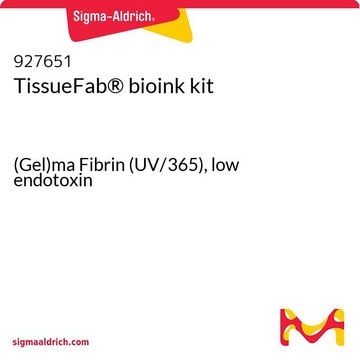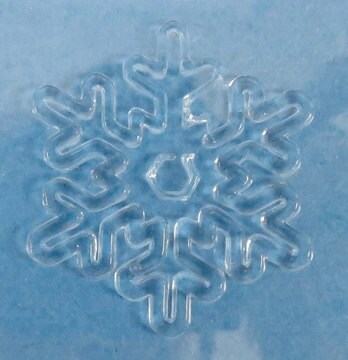927074
TissueFab® bioink kit
(Gel)ma Fibrin (Vis/405), low endotoxin
Synonym(s):
Fibrin, Fibrinogen, GelMA, Gelatin methacrylamide, Gelatin methacrylate, Gelatin methacryloyl, Thrombin
About This Item
Recommended Products
Quality Level
form
(Solid chunks, fibers or powder)
impurities
<10 CFU/g Bioburden (Fungal)
<10 CFU/g Bioburden (Total Aerobic)
<125 EU/g Endotoxin
color
, Pale white to colorless
application(s)
3D bioprinting
storage temp.
2-8°C
Looking for similar products? Visit Product Comparison Guide
Related Categories
General description
The protocol can be found under "More Documents" at the bottom of the page.
TissueFab® bioink kit- (Gel)ma Fibrin (Vis/405), low endotoxin contains:
2- 500 mg lyophilized ink components
1- lyophilized thrombin powder
1- 10 ml HEPES buffer.
Gelatin methacryloyl (GelMA) is a polymerizable hydrogel material derived from natural extracellular matrix (ECM) components. Due to its low cost, abundance, and retention of natural cell binding motifs, gelatin has become a highly sought material for tissue engineering applications. Fibrinogen is a soluble glycoprotein produced by liver. It can be emzymatically polymerized to fibrin monomers by thrombin and then to fibrin based blood clot during blood coagulation. With multi cell binding sites, such as RGD (Arg-Gly-Asp), fibrin plays an important role in celluer-matrix interaction, can promote cell adhesion, proliferation and migration.
Application
Features and Benefits
Low Endotoxin, low bioburden: Endotoxins have been demonstrated negatively impact cellular growth, morphology, differentiation, inflammation and protein expression. Bioburden is defined as the number of contaminated organisms found in a given amount of material. We test each lot for endotoxins as well as total bioburden (aerobic and fungal) to minimize unwanted interactions. For more information: https://www.sigmaaldrich.com/US/en/technical-documents/technical-article/microbiological-testing/pyrogen-testing/what-is-endotoxin
Legal Information
related product
Signal Word
Danger
Hazard Statements
Precautionary Statements
Hazard Classifications
Eye Irrit. 2 - Resp. Sens. 1 - Skin Irrit. 2 - STOT SE 3
Target Organs
Respiratory system
Storage Class Code
10 - Combustible liquids
Choose from one of the most recent versions:
Certificates of Analysis (COA)
Sorry, we don't have COAs for this product available online at this time.
If you need assistance, please contact Customer Support.
Already Own This Product?
Find documentation for the products that you have recently purchased in the Document Library.
Our team of scientists has experience in all areas of research including Life Science, Material Science, Chemical Synthesis, Chromatography, Analytical and many others.
Contact Technical Service










